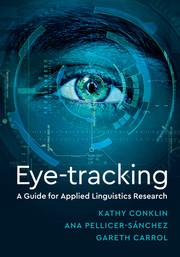Book contents
- Frontmatter
- Contents
- Figures
- Tables
- Preface
- Chapter 1 Introduction to Eye-Tracking
- Chapter 2 Choosing the Equipment
- Chapter 3 Practicalities of Eye-Tracking
- Chapter 4 Researching Reading
- Chapter 5 Researching Listening and Multimodal Input
- Chapter 6 Using Eye-Tracking in Other Contexts
- Chapter 7 Working with the Data
- Chapter 8 Conclusions
- References
- Index
1 - Introduction to Eye-Tracking
Published online by Cambridge University Press: 14 September 2019
- Frontmatter
- Contents
- Figures
- Tables
- Preface
- Chapter 1 Introduction to Eye-Tracking
- Chapter 2 Choosing the Equipment
- Chapter 3 Practicalities of Eye-Tracking
- Chapter 4 Researching Reading
- Chapter 5 Researching Listening and Multimodal Input
- Chapter 6 Using Eye-Tracking in Other Contexts
- Chapter 7 Working with the Data
- Chapter 8 Conclusions
- References
- Index
Summary
What Is Eye-Tracking?
Have you ever watched someone's eyes as they read or look at a scene? What do you notice about the eyes’ behaviour from simple observation? There are descriptions of eye-movements, as well as what they might tell us, that go back as far as Aristotle (Wade, 2010). However, this kind of observation only provides a limited understanding of eye-movements, and historically led to the erroneous conclusion that eyes ‘glide over scenes and to alight on objects of interest, which they would fix with unmoved accuracy’ (Wade and Tatler, 2011, p. 37). It was not until the late nineteenth and early twentieth centuries, when early eye-trackers were developed, that we gained insight into the rapid discontinuous nature of eye-movements.
We fancy that we can move our eyes uniformly, that by a continuous motion like that of a telescope we can move our eyes along the sky-line in the landscape or the cornice of a room, but we are wrong in this. However determinedly we try to do so, what actually happens is, that our eyes move like the seconds hand of a watch, a jerk and a little pause, another jerk and so on; only our eyes are not so regular, the jerks are sometimes of greater, sometimes of less, angular amount, and the pauses vary in duration, although, unless we make an effort, they are always short. During the jerks we practically do not see at all, so that we have before us not a moving panorama, but a series of fixed pictures of the same fixed things, which succeed one another rapidly.
(Brown, 1895, pp. 4–5)The ‘twitches’ and ‘jerks’ of the eye – in other words their movements – are what we commonly refer to as saccades. The interval between the eyes’ movements, when the eyes ‘stop’, are called fixations. Both are a type of automatic, physiological response, which means that they are not under our conscious control (Rayner et al., 2012). In reading, saccades do not always move the eye forward in a text. About 10–15 per cent of the time, readers move their eyes back (regress) to previously encountered sections of text. These backward movements are referred to as regressions. Regressions can be short or long. Short regressions are usually due to overshooting a target.
- Type
- Chapter
- Information
- Eye-TrackingA Guide for Applied Linguistics Research, pp. 1 - 13Publisher: Cambridge University PressPrint publication year: 2018
- 3
- Cited by



